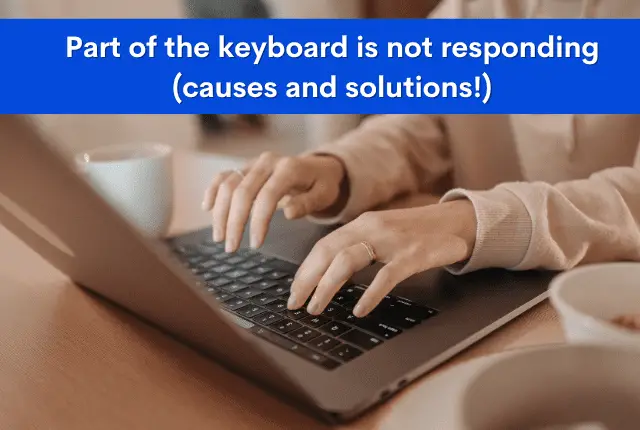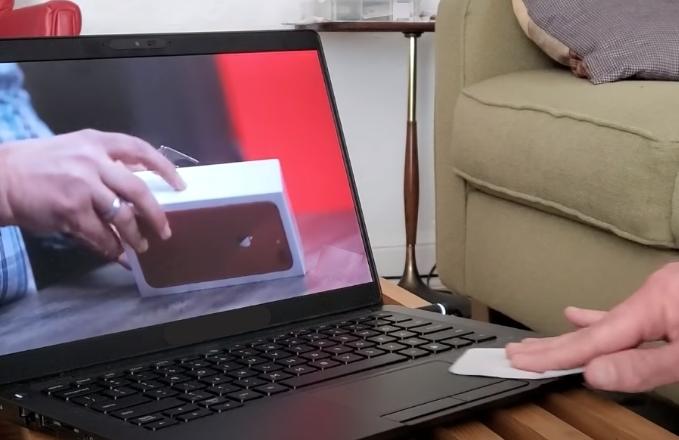Part of the keyboard is not responding (causes & solutions)
Experiencing issues with typing because some parts of the keyboard do not respond. If you continue to use it as it is, stress will accumulate. Additionally, the problem may spread to other keys or other parts of your computer.
In this article, we will explain the causes and solutions for the keyboard not responding partially. We have also summarized what to do if your keyboard keys come off.
Reasons why some parts of the keyboard do not respond

First of all, it is important to clarify the cause. By identifying the cause, you can find solutions, the cause may be one of the following:
1. Configuration issues
If your keyboard is unresponsive, it could be due to your keyboard settings. For example, the activation of the NumLock key or Mouse Keys, or, for external keyboards, a malfunctioning Bluetooth connection.
Also, if the keyboard responds, but the response is a little slow, it may be that filter keys are enabled. The filter key function is a function that allows the computer to ignore commands when a “key operation that seems to be a malfunction” occurs, such as when a key is pressed briefly or repeatedly.
If you notice something strange about your keyboard, try turning this off. Here are the steps to turn off filter keys:
Steps to turn off filter keys
- Click “Start button”
- Click “Settings”
- Click “Easy operation” > “Keyboard”
- Turn off “Use Filter Keys”
2. Dirt or dust inside
If your keyboard doesn’t respond well, there may be dirt or dust inside. A key on the keyboard might only work when pressed from a different angle, indicating that that dirt or dust has accumulated inside the keyboard.
Given the daily use of keyboards, they are prone to collecting dust and dirt, making regular cleaning not just a matter of functionality but also of hygiene, so we recommend cleaning the keyboard regularly.
3. Spilled water
It’s common to spill water on your keyboard and end up with some keys becoming unresponsive. This issue becomes more acute with liquids that contain impurities, like juices and seasonings. Even if you wipe it thoroughly, it may become unresponsive or the key may become stuck and not return.

Additionally, for laptops, the keyboard is integrated into the main body. Therefore, water spilled on the keyboard can corrode the inside’s PCB and damage the base. If this happens, other parts may be affected, and in the worst case, your computer may become unusable.
4. Key is physically damaged
It is also possible that the key is physically damaged. Dropping your keyboard or typing with excessive force can lead to broken keys. This is especially true for laptop keyboards, which are known for their delicate construction. Many laptop keyboards use a pantograph mechanism, which, while allowing for a slimmer design and quieter typing experience, but it also breaks easily and must be handled with care.
5. Battery
The keyboard may become partially unresponsive due to battery. As the battery deteriorates, the lithium battery inside may generate gas and cause the battery to swell.
When it expands, it not only makes it difficult to type on the keyboard, but also poses a risk of fire and smoke. This is a dangerous condition, so we recommend that you repair or replace it immediately.
Solutions, if the keyboard is partially unresponsive
If your keyboard is not responding at all, we recommend that you try the following four steps.
1. Restart your computer
If your keyboard is not responding, we recommend restarting your computer. When you restart your computer, your computer’s memory will be reset. If it’s just a temporary problem that causes it to not respond, restarting will often fix the problem.
Follow the steps below to restart your computer. Steps to restart your computer
- Click “Start button”
- Click “Power”
- Click “Restart”
2. Check Num Lock and Mouse Keys
If some keys don’t respond, check your Num Lock key. NumLock is a function that allows you to switch to numeric input mode. If the numeric keypad is unresponsive, NumLock may be turned off. You can turn it on/off by pressing the key labeled “NumLock”.
3. Clean the keyboard
If dirt or dust gets into the keyboard, it may become less responsive. We recommend cleaning your keyboard regularly.Here are some example steps to clean your laptop keyboard: (For detailed instructions, please refer to the instruction manual or the manufacturer’s website.)
Steps to clean your laptop keyboard
- Turn off your computer
- Discharge your computer by removing peripherals and batteries.
- Wipe the surface of the keyboard with an alcohol-based wet tissue
- Use air duster to remove dust and dirt inside.
- You can also get what you need to clean your keyboard at a 100 yen shop. Do not use air duster near fire.
4. Reinstall the driver
The problem may be fixed by reinstalling the keyboard driver. A driver is the software required to connect peripheral devices to a computer.
Especially if the driver is old, there is a high possibility of problems occurring, so we recommend updating it to the latest version by reinstalling it.
Here are the steps to reinstall the driver:
- Open “Device Manager” (type “Device Manager” in the search box)
- Select the keyboard you are using and right click
- Click “Uninstall device”
- Restart your computer
What should you do if your keyboad keys fall off?
If your keyboard loses a key, first inspect it for any damage. If it is not damaged, it can be reattached.
The method to reattach varies depending on the type of keyboard. For laptop computers, the common mechanism is a pantograph, characterized by four small protrusions. Each key has four tabs on its underside designed to fit these protrusions.
To reattach a key, align its tabs with the protrusions, then gently press down from above. The key should click back into place. After attaching, test the key to ensure it functions correctly. Be careful not to press the key too hard when putting it on, as the tabs and protrusions may break.
If the keyboard still doesn’t respond
If the keyboard still doesn’t work after trying the solutions mentioned above, there are two ways to deal with it:
1. Use the on-screen keyboard
Although it is only a temporary measure, you can also use the on-screen keyboard. The on-screen keyboard is a function that displays a keyboard on the screen and allows you to type characters using the mouse. However, with an on-screen keyboard, typing speed will naturally be slower. Since it is only a temporary measure, it is important to repair or replace the keyboard without leaving it unattended.
Follow the steps below to use the on-screen keyboard.
Steps to use the on-screen keyboard
- Click “Start button”
- Click “All apps”
- Click “Accessibility”
- Turn on “On-screen keyboard”
2. Use an external keyboard
Even if you have a laptop, you can still use an external desktop keyboard.
However, if you use an external keyboard, the touchpad becomes difficult to use, necessitating the addition of a mouse. Just like external hard drive, another disadvantage is that it is inconvenient to carry.
For ease of transport, opting for Bluetooth-connected keyboards over wired ones is advisable due to their superior portability.
